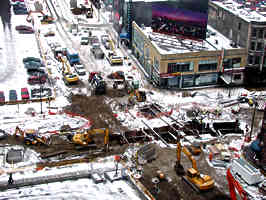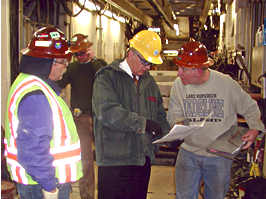 |
"Going multi-modal"
in fall 2004 is the ultimate reason for this closure of Hennepin Avenue
at Fifth Street.That’s when this intersection will begin carrying light
rail trains along with buses, cars, trucks, bikes and pedestrians. Photo
by Josh Collins
|
Downtown commuters, sports fans and music-lovers take note: the map of downtown
Minneapolis went out of date March 4. That’s when Fifth Street closed permanently
for construction of a new light rail transit station between Third and Fourth
avenues near Minneapolis City Hall—a site that’s four blocks west of the Hubert
H. Humphrey Metrodome and eight blocks northeast of Target Center.
The Fifth Street block closing serves as one more tangible sign that LRT
is coming to Minneapolis. Last fall private utility companies began temporarily
closing downtown Minneapolis streets in order to relocate underground lines
in preparation for LRT. A six-week closure of Fifth Street at Hennepin Avenue
began two weeks ago for the same reason.
"We’ve heard from the City of Minneapolis’s transportation staff that
downtown traffic is moving fairly smoothly," said Joshua Collins,
community outreach specialist, Mn/DOT Hiawatha Project Office. "We have
been encouraging commuters to find alternate routes for months, and a lot of
the traffic that used to use Fifth Street has shifted elsewhere."
Utility relocation east of Nicollet Mall is complete now, with construction
beginning as soon as utility crews move on to the next block, according to Jack
Caroon, Mn/DOT design/build project manager, Hiawatha Project Office.
"We did start actual construction of LRT downtown back on Feb. 4,"
Caroon said. "Construction crews have already stripped the pavement off
four blocks along Fifth Avenue east of Nicollet Mall, and they’ll continue to
move northwest following Fifth Street."
Next up for private utility relocation work is the Fifth Street intersection
with Nicollet Mall, a buses-pedestrians-only street running parallel to the
heavily traveled Hennepin Avenue, two blocks from Target Center. This would
go on for eight weeks, Caroon said, and will probably begin early in April.
The downtown area has been a favorite venue for running and biking road races,
but construction will have only a minimal effect on race participants, Collins
said.
"We’ve already coordinated with one of the races on May 25," he said,
"and we’re going to make sure that there’s a safe and clear path running
between the construction areas."
 |
|
Mn/DOT Commissioner
Elwyn Tinklenberg (center) reviews plans with a crew member (right) who's
helping to dig two light rail tunnels underneath Minneapolis-St. Paul
International Airport. At left is Sakir Selcuk, deputy construction coordinator
for HNTB, the Metropolitan Airports Commission consultant. Photo by
Bob Winter
|
Outside of the downtown Minneapolis area, LRT construction continued this winter
on other changes to the Minneapolis map, including a new flyover bridge at 28th
Street and Hiawatha Avenue. Work continues at other Hiawatha Avenue sites, including
Hwy 62 and Hwy 55 near Minneapolis-St. Paul International Airport in Richfield
along the southern border of Minneapolis.
Work also continued throughout the winter on the tunnel beneath the airport.
The southbound tunnel, currently half finished, should be complete in April,
Collins said. The tunnel-boring machine will begin the northbound tunnel immediately
after completion of the southbound tunnel.
Once the weather warms up, activity will pick up dramatically.
"Construction will get cranked up early this spring," Collins said.
"We have plans to lay a significant amount of track. It’s really going
to start looking like a rail line."
Construction of the first portion of the light rail line should be complete
in late 2003, with the remainder opening in fall 2004. Metro Transit plans to
begin operating the LRT line for partial service in late 2003 from Nicollet
Mall to Fort Snelling. Once the entire LRT line is open, travelers will be able
to get on and off the train at any of 17 light rail stations at the airport,
along Hiawatha Avenue, and in downtown Minneapolis.
|



